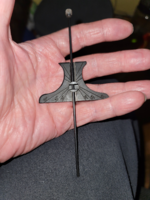Penchant 4
Member
To check the depth of smaller diameter blind holes, I ordered the P.E.C. 6″ Depth Gage (7003-006), which includes a 3/32" diameter rod. It was ordered from McMaster-Carr (item # 20445A46). The clevis would not lock the rod in position. I contacted McMaster-Carr and they sent a replacement, with an apology for my inconvenience at receiving a defective item.
The replacement gauge would not lock the rod in place.
In three separate examples of this gauge, none of them would lock the rod to the body when attempting to check the depth of a hole bored square to a surface. It appears that the holes in the wings of the clevis are not drilled properly, i.e. too far from the base that rests against the body. In the photo attached, the rod will not even center in the trough.
I emphasize that McMaster-Carr have been helpful in trying to resolve this problem. In the course of the email exchanges with McMaster-Carr however, it does sound like P.E.C. told them that I did not know how to use the gauge.
Has anyone using this gauge had success with locking the rod to the body when checking a hole at 90 degrees?
The replacement gauge would not lock the rod in place.
In three separate examples of this gauge, none of them would lock the rod to the body when attempting to check the depth of a hole bored square to a surface. It appears that the holes in the wings of the clevis are not drilled properly, i.e. too far from the base that rests against the body. In the photo attached, the rod will not even center in the trough.
I emphasize that McMaster-Carr have been helpful in trying to resolve this problem. In the course of the email exchanges with McMaster-Carr however, it does sound like P.E.C. told them that I did not know how to use the gauge.
Has anyone using this gauge had success with locking the rod to the body when checking a hole at 90 degrees?

